#Tatpurusha
Explore tagged Tumblr posts
Text
Nova Iuncta Verba Latina / New Latin Compounds
porcinigladius -ii m. “pork sword” [porcina “pork” + gladius “sword”] [porcina- + gladio-] stems [porcini- + gladio-] a becomes Connecting Vowel i [porcinigladio-] new stem [porcinigladius] nominative singular

(Fons Imaginis.)
#New Latin Compounds#latin#latin language#latin translation#lingua latina#latin fandom#latin meme#latin memes#meme#memes#Word Formation#Latin Word Formation#Tatpurusha
3 notes
·
View notes
Text

"Kubjikā a secret goddess, having immense metaphysical depth, a large varieties of forms, and varied methods of yoga (especially those linked with the movement of vital breath), appears in the Bhairava and then the Western Kaula Tantra (Paschima-amnaya ) Traditions of the Himalayan regions during 7th century. She is variously addressed in her Tantras as :Kubjinī – the Hunchback Girl; Kubjī, Kujā, Kujī, Khañjinī – the Lame One; Vakrikā or Vakrā – the Crooked One; Ciñcinī – the Goddess residing in the Tamarind tree; Kulālikā – the Potteress; Ambā or the vernacular forms as : Avvā, Anāmā, Laghvikā; and, most common of all as Śrī – the Royal One who has as her scripture, teaching, school and tradition (anvaya, āmnāya); and as the Śrīmata. Kubjinī, a very secret goddess is worshiped in her Tantras along with Bhairava, her consort. As Kundalini, Kubjika is worshipped as the Goddess who is curled up and sleeping, waiting to be awakened. The sect of Nine Natahas is believed to have propagated the cult of Kubjika throughout Nepal and North India.
In the Kaula Tantra (Paschima-amnaya) Tradition, Devi Kubjika is worshiped with Shiva with his five faces Sadyojata; Vamadeva, Tatpurusha; Aghora and Ishana.. The hallowed mother Kubjika has six faces.
She is adorned with serpents: Karotaka as a waist band; Takshaka as a mid-riff ornament; Vasuki as garland; and, the venomous cobra Kulika as an ear ornament.
She holds in her arms as skull, a king-cobra, a crystal-bead rosary, skull-topped rod, a conch, a book, a trident, a mirror, a straight sword, a gem necklace, an ankusha (goad) and a bow. She is of fair complexion like a young jasmine flower.
The mantra of Kubjika is Om Shrim Prim Kubjike Devi Hrim Thah Svaha
As per the Kaula Tantra (Paschima-amnaya), Lord Bhairava initiates the Devi into the Kubjikā-mata-tantra, saying: Oh the Goddess of great fortune! O bestower of great bliss! (Mahābhāge Mahā-ananda-vidhāyini) The teaching that you have requested is truly astonishing and salutary (atyadbhutam anāmayam). That is kept secret by all the Rudras, Tantric heroes, and Bhairavas. Nevertheless, I will teach you that secret Tantra, which has come down through a series of transmissions,established through the line of Siddhas (Siddha mārga kramāyātaṃ Siddha paṅkti vyavasthitaṃ)..
Sādhu sādhu Mahābhāge Mahā-ananda-vidhāyini | pṛcchitaṃ yat tvayā vākyam atyadbhutam anāmayam || gopitaṃ sarva Rudrāṇāṃ vīrāṇāṃ Bhairaveṣu ca | Siddha-kramaṃ nirācāraṃ tathāpi kathayāmi te || Siddha mārga kramāyātaṃ Siddha paṅkti vyavasthitaṃ – Kubjikāmatatantra 1.44-46:
The Kaula Śhaiva Siddantha recognizes the lineage (santati) of four innately enlightened Siddhas (sāṃ-siddhika), the Masters of Four Ages (Yuga-nāthas) in the transmission (krama) of the Kaula-marga.
Abhinavagupta, in his Tantrāloka, recalls with reverence the Guru-linage (Guru-santati) , commencing with the four Siddhas, the Yuga-nāthas, together with their consorts: Khagendra and Vijjāmbā; Kūrma and Maṅgalā; Meṣa and Kāmamaṅgalā; and finally, Macchanda (Matsyendranātha) and Kuṅkuṇāmbā (Koṅkaṇā).
khagendraḥ sahavijjāmba illāri ambayā saha || vaktaṣṭir vimalo ‘nantamekhalāmbāyutaḥ purā | śaktyā maṅgalayā kūrma illāri ambayā saha || jaitro yāmye hy avijitas tathā sānandamekhalaḥ | kāmamaṅgalayā meṣaḥ kullāri ambayā saha || vindhyo ‘jito ‘py ajarayā saha mekhalayā pare | macchandaḥ kuṃkuṇāmbā ca ṣaḍyugmaṃ sādhikārakam. – Tantrāloka 29.29cd-31:
Matsyendranātha or Macchandanātha, the most iconic Siddha, is said to be primarily responsible for the spread of the Kaula-marga of the Shaiva Siddantha in this Kali Age.
Apart from Matsyendranātha, some other Siddhas were also said to have played an important role in propagation of the Kula-mārga.
The Tantric text, Devīpañcaśatikā, mentions the set of four other Siddha-couples: Niṣkriyānanda and Jñānadīpti; Vidyānanda and Raktā; Śaktyānanda and Mahānandā; and , Śivānanda and Samayā
niṣkriyānandanāthaś ca jñānadīptyā sahaikataḥ ||vidyānandaś ca raktā ca dvitīyaḥ kathitas tava | śaktyānando mahānandaḥ tṛtīyaḥ siddhapūjitaḥ || śivānando mahānandaḥ samāyātaś caturthakaḥ | khagendrādyādisiddhānāṃ kathitā gurusantatiḥ – Devīpañcaśatikā 3.15cd-17."
https://sreenivasaraos.com/tag/kubjika-tantra/
4 notes
·
View notes
Text
ASIAN MYTHOLOGY
-Hindu Mythology-
Here is a piece of the larger framework of Asian mythology located in India
हिंदूपौराणिक कथा will refer to the mythological framework of people in INDIA near the INDUS VALLEY that has been upheld for nearly FOUR MILLENNIA. Creation is accredited to Brahma; the creator of everything. He will, nonetheless, emerge from a GOLDEN EGG. Its pantheon, including him, will center around the TRINITY OF GODS that will include BRAHMA, VISHNU, AND SHIVA. There are other deities that exclude THE TRINITY that will represent GOD in another form known as an AVATAR. From this, the mythology made in their image was given to account for the CUSTOMS of the people of India.
THE GODS OF THE TRINITY
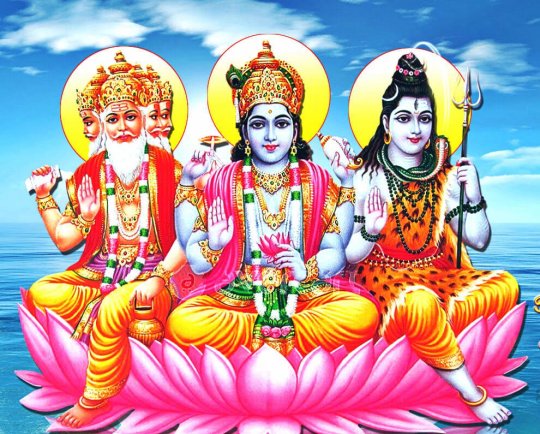
■LORD BRAHMA is the creator
■LORD VISHNU is the God tasked with the preservation of creation
■LORD SHIVA is the destroyer
------------------------------------------
[2]
THE AVATAR OF BRAHMA
1st AVATAR
■Valmiki -> वाल्मिकि
2nd AVATAR
■Kashyapa -> कश्यप
3rd AVATAR
■Shukra -> शुक्र
4th AVATAR
■Bachesa -> बचेसा
5th AVATAR
■Vyasa -> व्यासः
6th AVATAR
■Khata -> खटा
7th AVATAR
■Kalidasa -> कालिदासः
THE AVATAR OF VISHNU ARE CALLED -> Dasavatara
1st AVATAR
■Matsya -> मत्स्य
Vishnu took the form of Matsya to rescue the first man, as well as any other creature of the earth, from a global disaster. He accomplished this by having forewarned mankind about the coming flood, and he ordered him to gather up all of the grain and to preserve any creature in a great boat.
2nd AVATAR
■Kurma -> कूर्म
Vishnu took the form of Kurma to churn the ocean in order to reach any treasure dissolved in the ocean of milk. He placed it on his back for support, which gave him the leverage needed to stir that great volume.
3rd AVATAR
■Varaha -> वराह
Varaha raised the earth from the bottom of the sea after Hiranyaksha dragged it there; it only took a millennia to do that, but he did it.
4th AVATAR
■Narasimha -> नरसिंह
Hiranyakashipiu obtained a special blessing from Brahma that he could not be killed or harmed by any means. That made him arrogance. As a result, he began causing trouble both in heaven and on earth. Prahlada, however, was devoted to Vishnu. Angered by that, he challenged his son to fight him. Narasimha emerged. And then, he slayed Hiranyakashipiu.
5th AVATAR
■Vamana -> मातरः
6th AVATAR
■Parashurama -> परशुरामः
7th AVATAR
■Rama -> रामः
8th AVATAR
■Krishna -> कृष्ण
9th AVATAR
■Buddha -> बुद्धः
10th AVATAR
■Kalki -> कल्कि
THE AVATAR OF SHIVA
1st AVATAR
■Tatpurusha -> तत्पुरुषः
2nd AVATAR
■Namadeva -> नामदेव
3rd AVATAR
■Aghoresh -> अघोरेश
4th AVATAR
■Sadhojat -> वनस्पति
5th AVATAR
■Ishan -> ईशान
------------------------------------------
LINEAGE OF SHIVA
Lord Shiva with Devi Sati

Lord Shiva and Devi Parvati
■Kartikeya
His first son
■Ganesha
His second son
■Ashoka
His daughter
2 notes
·
View notes
Text
Top 5 Amazing Facts About Pashupatinath Temple

Nepal has an extremely bewitching landscape that has often captivated the onlookers. Its subalpine forested hills, snow-capped mountains, lush green meadows, and rich biodiversity perfectly intensifies its beauty. As a popular destination for adventure tourism, Nepal is loved by adventure enthusiasts and nature lovers alike.
However, beyond being a popular destination for adventure activities, Nepal is home to several beautiful Hindu temples as well. And so, temple-hopping is another popular thing to do in Nepal. The capital city of Nepal—Kathmandu offers you a perfect opportunity to lose yourself a little with the dose of spirituality. One of the most oldest and popularly visited temples in Nepal is Pashupatinath Temple. The Pashupatinath Temple location is Kathmandu city. The temple is located near the holy Bagmati river. Tribhuvan International Airport, Kathmandu is the nearest airport which is located at a distance of 2-3 km from the temple.
The Pashupatinath Temple of Nepal was listed as one of the UNESCO World Heritage Sites in 1979. This temple is dedicated to Lord Shiva. Pashupatinath Temple’s inside sanctum sanctorum houses a Shiva-Lingam. The outer sanctum has a huge corridor. An enormous statue of Nandi Bull–Lord Shiva’s vehicle stands tall facing the temple complex. The temple has a gold-plated roof that gives it a striking appearance along with four silver-plated gates. It is constructed in the traditional Nepalese pagoda style. Lord Shiva is the principal deity who is worshipped here as ‘Pashupatinath’ or the ‘Lord of Animals’. The importance of Pashupatinath temple is that Lord Shiva is also worshipped here as the protector of the animals. The temple has a very tranquil atmosphere. One can spot numerous shrines, temples, and ashrams inside the temple complex. Sadhus and yogis come to the temple to meditate and offer prayers to Mahadev. If we talk about the importance of Pashupatinath Temple, then his temple finds its mention in Skanda Purana as one of the holy abodes of Lord Shiva. It is believed that by worshipping Lord Pashupatinath one can attain moksha or liberation.
The temple draws millions of tourists from different parts of India, especially during the festival of Mahashivratri. It is the perfect time to do the Pashupatinath Temple darshan as the temple comes alive with celebratory spirits and several sacred rituals.
The Pashupatinath Temple’s story is that once a group of herdsmen noticed their cow pouring its milk on the soil. Later, they found a sacred Lingam while digging the soil. Since then, the Lingam has been worshipped as ‘Lord Pashupatinath’. The temple is one of the revered Hindu pilgrimage sites.
Well, if you like temple-hopping, then Nepal’s Pashupatinath Temple should be on your travel bucket list. Here are the Top 5 untold facts about Pashupatinath Temple you need to know.
1. Four-faced Shiv Lingam
The temple houses a unique four-faced Shiva Lingam. This kind of Lingam can’t be found in any of the temples of Lord Shiva. The four faces of the Lingam are—Tatpurusha (East facing), Sadhyojata (West facing), Vamdeva (North-facing), and Aghora (South facing).
2. Four Priests At The Temple
Not many know that only four priests are allowed inside the inner sanctum of the temple. There are two groups of priests—Bhatta and Rajbhandari that perform the rituals at the holy Shiv Lingam.
3. Arya Ghat
Arya Ghat is the sacred Ghat located near Pashupatinath Temple. The holy waters of this Ghat are used to worship Lord Pashupatinath. It is also a cremation ground.
4. Only Hindus Are Allowed
Another interesting fact about the temple is that only Hindus are allowed entry inside the sanctum sanctorum of the temple.
5. Collection of Paintings, Sculptures And Inscriptions
The temple has a rich collection of inscriptions, paintings, and sculptures. The doors of the temple are beautifully adorned with eye-catching artwork. You can see a few of them in Pashupatinath Temple photos.
If you are seeking a spiritual retreat and a calming experience, Pashupatinath Temple is a must-visit temple. Don’t wait any longer! Satisfy your spiritual quest by sauntering through the beautiful temple complex of Pashupatinath Temple. Lose yourself a little into the dose of spirituality like never before. Get in touch with our team of travel experts to learn more about Pashupatinath Temple tour packages or Nepal tour packages.
0 notes
Text
𝗦𝗜𝗩𝗔'𝗦 𝗣𝗢𝗪𝗘𝗥 தமிழில்
𝟭.𝗦𝗮𝗱𝘆𝗼𝗷𝗮𝘁𝗮: Siva's Power of Creation
Sadyojata ("quickly birthing"), the controlling Lord of Brahma, is the aspect of Siva that wields the power of creation. His direction is west, He is related to the sphere of earth (prithivi mandala) and His Panchakshara Mantra syllable is Na. The Agamas describe Him as white in color, in the likeness of a boy with a charming face, besmeared with sandalwood paste, adorned with white flowers. One hand displays the boon-granting varada mudra and another the fear-not abhaya mudra. He is Siva manifest in all of nature; the causer of birth.
𝟮.𝗩𝗮𝗺𝗮𝗱𝗲𝘃𝗮: Siva's Power of Preservation
Vamadeva ("lovely, pleasing"), the controlling Lord of Vishnu, is the aspect of Siva that wields the power of preservation. His direction is north, He is related to the sphere of water (jala mandala), and His Panchakshara Mantra syllable is Ma. The Agamas describe Him as red in color, with a handsome face and aristocratic bearing, wearing rich apparel, a turban and garlands of flowers. He holds a sword and a shield.
𝟯.𝗔𝗴𝗵𝗼𝗿𝗮: Siva's Power of Dissolution
3. Aghora ("non terrifying"), the controlling Lord of Rudra, is the aspect of Siva that wields the power of dissolution. His direction is south, He is related to the sphere of fire (agni mandala), and His Panchakshara Mantra syllable is Si. The Agamas state that Aghora Deva is the color of dark cloud and is adorned with crescent studded crown and beautiful earring. Though His expression is pleasant, His appearance is dreadful, with long, projecting teeth, and a tawny colored beard, moustache and matted hair. He is adorned with snakes and scorpions and a garland of skulls. The four hands on the left side hold a fire, khatvanga (a staff with a skull at its top), shield and noose. The four hands in the right side hold a trident, hatchet, sword and staff.
𝟰.𝗧𝗮𝘁𝗽𝘂𝗿𝘂𝘀𝗵𝗮: Siva's Power of Obscuration
Tatpurusha ("supreme soul"), the controlling Lord of Maheshvara, is the aspect of Siva that wields the power of obscuration. His direction is east, He is related to the sphere of air (vayu mandala), and His Panchakshara Mantra syllable is Va. The Agamas describe Tatpurusha Deva as gold in color, dressed in yellow silken cloth, head adorned with a crown and crescent moon. In one hand he holds a string of beads and in another His trident staff
𝟱.𝗜𝘀𝗵𝗮𝗻𝗮: Siva's Power of Revealment
Ishana ("ruler"), the controlling Lord of Sadasiva, is the aspect of Siva that wields the power of revealment. His direction is upward, He is related to the sphere of ether (akasha mandala), and His Panchakshara Mantra syllable is Ya. The Agamas describe Ishana Deva as pure crystal in color, with three eyes. In one hand He holds a trident and in another a string of beads. His two other hands present the abhaya ("fear not") and dhyana (meditation mudras. Bearing a crescent on His crown, His form is charged with benevolence.
சிவனின் சக்தி
1.சத்யோஜாதா: சிவனின் படைப்பின் சக்தி
சத்யோஜாதா (“விரைவில் பிறப்பது”), பிரம்மாவின் கட்டுப்பாட்டாளர், படைப்பின் சக்தியைப் பயன்படுத்தும் சிவனின் அம்சமாகும். அவரது திசை மேற்காகும், அவர் பூமியின் கோளத்துடன் (பிரிதிவி மண்டலம்) தொடர்புடையவர், அவரது பஞ்சாக்ஷர மந்திரத்தின் எழுத்து “ந”. ஆகமங்கள் அவரை வெண்மையான நிறத்தில், அழகான முகத்துடன் சிறுவனின் உருவத்தில், சந்தனப் பேஸ்டால் பூசப்பட்டு, வெள்ளை மலர்களால் அலங்கரிக்கப்பட்டு இருப்பதாக விவரிக்கின்றன. ஒரு கையில் வரத முத்திரையை (வரம் அளிக்கும் முத்திரை) மற்றும் மற்றொரு கையில் அபய முத்திரையை (பயப்படாதீர்கள்) காட்டுகிறார். அவர் இயற்கையில் வெளிப்படும் சிவன்; பிறப்பின் காரணம்.
2.வாமதேவா: சிவனின் பாதுகாப்பின் சக்தி
வாமதேவா (“அழகான, மனதைக் கவரும்”), விஷ்ணுவின் கட்டுப்பாட்டாளர், பாதுகாப்பின் சக்தியைப் பயன்படுத்தும் சிவனின் அம்சமாகும். அவரது திசை வடக்காகும், அவர் நீரின் கோளத்துடன் (ஜல மண்டலம்) தொடர்புடையவர், அவரது பஞ்சாக்ஷர மந்திரத்தின் எழுத்து “ம”. ஆகமங்கள் அவரை சிவப்பு நிறத்தில், அழகான முகத்துடன், அரச குணத்துடன், செல்வச் சீருட��� அணிந்த, ஒரு தலையில் துர்பான் மற்றும் மலர்களின் மாலைகள் அணிந்தவராக விவரிக்கின்றன. அவர் ஒரு வாள் மற்றும் ஒரு கேடயம் பிடித்துள்ளார்.
3.அகோரா: சிவனின் அழிவின் சக்தி
அகோரா (“பயமுறுத்தாத”), ருத்ராவின் கட்டுப்பாட்டாளர், அழிவின் சக்தியைப் பயன்படுத்தும் சிவனின் அம்சமாகும். அவரது திசை தெற்காகும், அவர் நெருப்பின் கோளத்துடன் (அக்னி மண்டலம்) தொடர்புடையவர், அவரது பஞ்சாக்ஷர மந்திரத்தின் எழுத்து “சி”. ஆகமங்கள் அகோர தேவனை இருண்ட மேகத்தின் நிறத்தில், சந்திரக்கலையால் அலங்கரிக்கப்பட்ட கிரீடம் மற்றும் அழகான காதணியுடன் இருப்பதாக விவரிக்கின்றன. அவரது முகபாவனை இனிமையாக இருந்தாலும், அவரது தோற்றம் பயங்கரமாக உள்ளது, நீண்ட, முன்னேறிய பற்கள், மற்றும் மஞ்சள் நிற தாடி, மீசை மற்றும் சிகை. அவர் பாம்புகள் மற்றும் தேள் மற்றும் ஒரு மண்டையோட்ட மாலையால் அலங்கரிக்கப்பட்டுள்ளார். இடது பக்கத்தில் உள்ள நான்கு கைகள் ஒரு நெருப்பு, காட்வாங்கா (தலையோட்டம் கொண்ட ஒரு ஊன்றுகோல்), கேடயம் மற்றும் கயிறு ஆகியவற்றைக் கொண்டுள்ளன. வலது பக்கத்தில் உள்ள நான்கு கைகள் ஒரு திரிசூலம், கோடரி, வாள் மற்றும் ஊன்றுகோல் ஆகியவற்றைக் கொண்டுள்ளன.
4.தத்புருஷா: சிவனின் மறைப்பின் சக்தி
தத்புருஷா (“உயர்ந்த ஆன்மா”), மகேஸ்வராவின் கட்டுப்பாட்டாளர், மறைப்பின் சக்தியைப் பயன்படுத்தும் சிவனின் அம்சமாகும். அவரது திசை கிழக்காகும், அவர் காற்றின் கோளத்துடன் (வாயு மண்டலம்) தொடர்புடையவர், அவரது பஞ்சாக்ஷர மந்திரத்தின் எழுத்து “வ”. ஆகமங்கள் தத்புருஷ தேவனை பொன்னிறத்தில், மஞ்சள் பட்டாடை அணிந்த, தலையில் கிரீடம் மற்றும் சந்திரக்கலையால் அலங்கரிக்கப்பட்டவராக விவரிக்கின்றன. ஒரு கையில் அவர் முத்துக்கள் கொண்ட ஒரு மாலையைப் பிடித்துள்ளார், மற்றொரு கையில் அவரது திரிசூல ஊன்றுகோலைப் பிடித்துள்ளார்.
5.இஷானா: சிவனின் வெளிப்படுத்தும் சக்தி
இஷானா (“ஆட்சி செய்பவர்”), சதாசிவாவின் கட்டுப்பாட்டாளர், வெளிப்படுத்தும் சக்தியைப் பயன்படுத்தும் சிவனின் அம்சமாகும். அவரது திசை மேலாகும், அவர் ஆகாய மண்டலத்துடன் (ஆகாச மண்டலம்) தொடர்புடையவர், அவரது பஞ்சாக்ஷர மந்திரத்தின் எழுத்து “ய”. ஆகமங்கள் இஷான தேவனை தூய கண்ணாடி நிறத்தில், மூன்று கண்களுடன் இருப்பதாக விவரிக்கின்றன. ஒரு கையில் அவர் ஒரு திரிசூலத்தைப் பிடித்துள்ளார், மற்றொரு கையில் முத்துக்கள் கொண்ட ஒரு மாலையைப் பிடித்துள்ளார். அவரது மற்ற இரண்டு கைகள் அபய (“பயப்படாதீர்கள்”) மற்றும் தியான முத்திரைகளை (தியான முத்திரை) காட்டுகின்றன. அவரது கிரீடத்தில் சந்திரக்கலையைத் தாங்கியுள்ள அவரது உருவம் கருணையால் நிரம்பியுள்ளது.

0 notes
Text
"Purusha." From the Rudraksha Jabala Upanishad, the Exploration of the Mysteries of the Metronome.
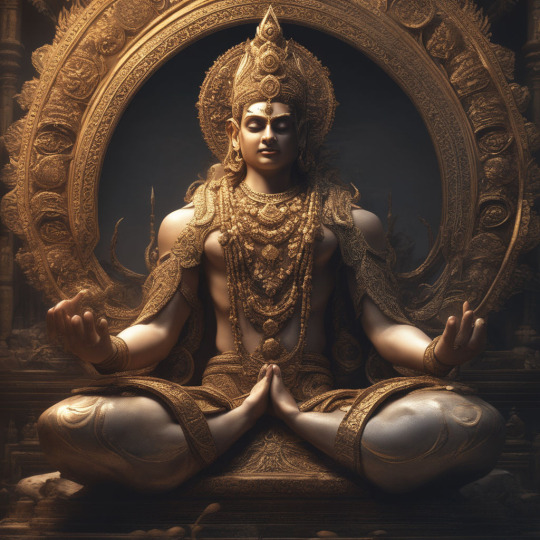
The devotee, when wearing Rudrakshas on the head, should repeat his Ishta Mantra (to his personal deity), and when wearing them round the neck, should repeat the Tat-Purusha Mantra and when wearing round the throat, should repeat the Aghora Mantra.
The Tatpurusha Gayatri Mantra is offered to Murugan, the god of War and Justice, who is also called Kartik and Krishna,
Om Tatpurushaya vidmahe Mahadevaya Dhimahi
Tanno Rudra prchodayat
“Homage to the spark of life, the greatest God, the most learned, the destroyer of ignorance and suffering, please hear our prayers.”
The same Mantra (Aghora) should be recited when wearing round the chest also. He should wear them round the arms with the Aghora Bija Mantra:
oṃ aghorebhyo'tha ghorebhyo ghora ghora tarebhyaḥ
sarvebhyas sarva sarvebhyo namaste'stu rudra rūpebhyaḥ
“My salutations to those who are not terrible, to those who are terrible, and to those who are both terrible and not terrible.”
While the days are never the same, the Self is always the Self. Once the sperm meets the egg in any creature, that One Self, called Purusha by the Upanishad merges them together and life begins and keeps beginning over and over. May we pay homage to all life in homage of Him.
0 notes
Video
youtube
🔴LIVE SPH DARSHAN: KAILASA's Karthigai Deepam Celebrations || 25th Nov 2023.
Bharani Deepam, a Great Flame is lit inside the Arunachaleshwara temple at 4’o o'clock in the morning. After invoking Paramshiva in the earthen lamps with all of his anga and avarana devatas, the Paramashiva-Jyoti, the Lamp of the Supreme Consciousness is lit from the sacred fire of Shiva Agni. From This lamp, 5 Lamps are lit before Arunachaleshwara Paramashiva invoking the divine presence of Paramashiva's 5 faces, Ishana, Tatpurusha, Aghora, Vamadeva, and Sadyojata,. From there the lamps are lit for Paramashivshakti and then all of the deities residing around the Arunachaleshwara Shrine.
The temple bells start clanging and the musicians beat on their drums. The temple walls resound with loud cries of devotion and the chanting of powerful Veda Mantras. This morning festival is Bharani Deepam, which happens under the nakshatra of Bharani. To all the Parivara Devatas, and Avarana Devatas, lamps are lit and maintained throughout the day.
In the evening the Maha Deepam festival happens when the lamps again return to a large lamp lit in the Temple of Arunachaleshwara.
Simultaneously upon the hill of Arunachala, a large lamp is lit and maintained for 11 days after the Karthigai Deepam Festival.
The significance of the Karthigai Deepam Festival is that the universal Paramashiva manifests the whole cosmos in the morning. In the evening He manifests and shines as the Tejolinga as the large lamps, and the Maha Deepam is lit on the Arunachala Hill, into whom the whole cosmos will unite into oneness. This festival is a celebration of Paramashiva creating the cosmos from Himself through the Bharani Deepam, and finally, the ultimate oneness with Paramashiva that He showers upon the whole cosmos.
#nithyananda #KAILASA #divinegrace #cosmicconsciousness #darshan #Deepam #tiruvannamalai #arunachaleswarartemple #thiruvannamalai #karthigaidheebam #karthigai#thiruvannamalai #karthigaidheebam #karthigai #deepam #annamalaiyar #arunachaleswarar #live #karthigaideepam #panchamurthy #procession #arunachala #tiruvannamalaideepamfestival2023 #deepam2023livetelecast #thiruvannamalai #karthigaideepam #karthigaideepam2023 #sriarunachaleshwara #live #karthigaideepamlive #thiruvannamalaikarthigaideepamlive #thiruvannamalaitemple #livekarthigaideepam #thiruvannamalai #arunachaleswarartemple #bharanideepam #bharanideepam2023 #karthigaideepam #mahadeepam #live #bharanideepam2023 #deepam2023 #karthigaideepam2023 #மகாதீபம் #தீபத்திருவிழா
0 notes
Video
youtube
🔴LIVE SPH DARSHAN: KAILASA's Karthigai Deepam Celebrations || 25th Nov 2023.
Bharani Deepam, a Great Flame is lit inside the Arunachaleshwara temple at 4’o o'clock in the morning. After invoking Paramshiva in the earthen lamps with all of his anga and avarana devatas, the Paramashiva-Jyoti, the Lamp of the Supreme Consciousness is lit from the sacred fire of Shiva Agni. From This lamp, 5 Lamps are lit before Arunachaleshwara Paramashiva invoking the divine presence of Paramashiva's 5 faces, Ishana, Tatpurusha, Aghora, Vamadeva, and Sadyojata,. From there the lamps are lit for Paramashivshakti and then all of the deities residing around the Arunachaleshwara Shrine.
The temple bells start clanging and the musicians beat on their drums. The temple walls resound with loud cries of devotion and the chanting of powerful Veda Mantras. This morning festival is Bharani Deepam, which happens under the nakshatra of Bharani. To all the Parivara Devatas, and Avarana Devatas, lamps are lit and maintained throughout the day.
In the evening the Maha Deepam festival happens when the lamps again return to a large lamp lit in the Temple of Arunachaleshwara.
Simultaneously upon the hill of Arunachala, a large lamp is lit and maintained for 11 days after the Karthigai Deepam Festival.
The significance of the Karthigai Deepam Festival is that the universal Paramashiva manifests the whole cosmos in the morning. In the evening He manifests and shines as the Tejolinga as the large lamps, and the Maha Deepam is lit on the Arunachala Hill, into whom the whole cosmos will unite into oneness. This festival is a celebration of Paramashiva creating the cosmos from Himself through the Bharani Deepam, and finally, the ultimate oneness with Paramashiva that He showers upon the whole cosmos.
#nithyananda #KAILASA #divinegrace #cosmicconsciousness #darshan #Deepam #tiruvannamalai #arunachaleswarartemple #thiruvannamalai #karthigaidheebam #karthigai#thiruvannamalai #karthigaidheebam #karthigai #deepam #annamalaiyar #arunachaleswarar #live #karthigaideepam #panchamurthy #procession #arunachala #tiruvannamalaideepamfestival2023 #deepam2023livetelecast #thiruvannamalai #karthigaideepam #karthigaideepam2023 #sriarunachaleshwara #live #karthigaideepamlive #thiruvannamalaikarthigaideepamlive #thiruvannamalaitemple #livekarthigaideepam #thiruvannamalai #arunachaleswarartemple #bharanideepam #bharanideepam2023 #karthigaideepam #mahadeepam #live #bharanideepam2023 #deepam2023 #karthigaideepam2023 #மகாதீபம் #தீபத்திருவிழா
0 notes
Text
Dwand Samas Ke Kitne Bhed Hote Hain
Dwand Samas, also known as compound words, are formed by combining two or more words to create a new word with a different meaning. In Sanskrit grammar, there are four main types of Dwand Samas. Avyayibhava Dwand: In this type, two words with similar meanings are combined to form a compound word. For example, "Gauri-Ganga" (Gauri and Ganga), where both words refer to rivers. Tatpurusha Dwand: In this type, the first word describes or qualifies the second word. For example, "Rama-Krishna" (Rama and Krishna), where Rama and Krishna are both names of deities. Karmadharaya Dwand: In this type, the first word acts as the object of the second word. For example, "Bhagya-Vidhata" (fortune and creator), where "Bhagya" (fortune) is the object of "Vidhata" (creator). Dvigu Dwand: In this type, both words have independent meanings but are combined to create a new word. For example, "Gau-Mutra" (cow and urine), where "Gau-Mutra" refers to cow urine. These are the four main types of Dwand Samas in Sanskrit grammar, each serving a different purpose in creating compound words.
0 notes
Text
Paraśiva - The highest form of Śiva.!
Don't forget to
♡ ㅤ ❍ㅤ ⎙ㅤ ⌲
ˡᶦᵏᵉ ᶜᵒᵐᵐᵉⁿᵗ ˢᵃᵛᵉ ˢʰᵃʳᵉ
the post and spread the knowledge.
With the grace of Śrī Guru and Śrī Matha 🙏
Thanks alot @saitharunvs bruh for helping Itivṛtta with the arts as well as @divine_saraswati anna for guiding me throughout.!
Namaḥ Pārvati Pataye
Hara Hara Mahādeva
Sāmba Sadāśiva Sāmba Sadāśiva Sāmba Sadāśiva
Namaḥ Śivāya
Śrī Lalitā Arpaṇam Astu 🪷🙏
#shiva #parashiva #itivratt #mamnonmani #sadasiva #sadyojata #aghora #vamadeva #ishana #tatpurusha #bramha #vishnu #rudra #ishvara #kailash #mahakal #harharmahadev #bholenath #hindu #lordshiva #hinduism #om #omnamahshivaya #bhole #bholebaba #shivshakti #shivshankar #mahadeva
instagram
1 note
·
View note
Text
Nova Derivativa Verba Latina / New Latin Derivatives
dissimulovinumerus -a -um “counting sheep in disguise” [dissimulare “to be in disguise” + ovis “sheep” + numerare “to count” + -us adjectival suffix] [dissimula- + ovi- + numera- + -o-] stems [dissimula- + ovi- + numer- + -o-] a disappears before o [dissimula- + ovi- + numero-] stems and new stem [dissimuli- + ovi- + numero-] a becomes Connecting Vowel i [dissimul- + ovi- + numero-] i disappears before o [dissimulovi- + numero-] new stem and stem [dissimulovi- + numero-] with Connecting Vowel i [dissimulovinumero-] new stem [dissimulovinumerus] present infinitive

(Fons Imaginis.)
#Ulterior Motives#Everyone Knows It#Everyone Knows That#EKT#latin#latin language#latin translation#lingua latina#latin meme#latin memes#meme#memes#Word Formation#Latin Word Formation#New Latin Derivatives#Tatpurusha
5 notes
·
View notes
Photo

Shiva Tatpurusha Tatpurusha is a form of Hindu god Shiva- the destroyer.
Artist: Pieter Weltevrede. Watercolour and wash on silk. (via amazon: SAGAR WORLD)
46 notes
·
View notes
Photo
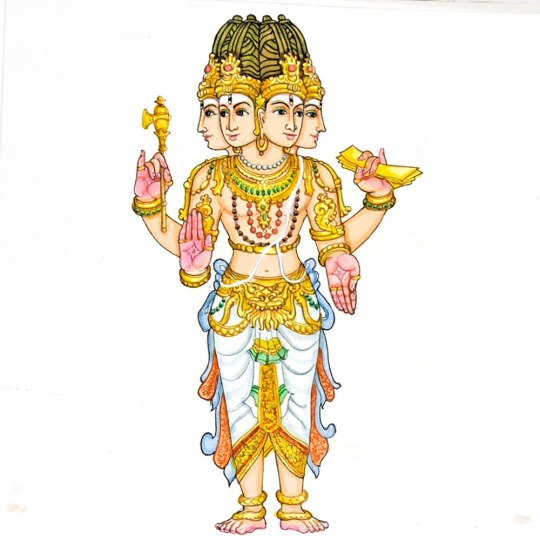
Shiva Tatpurusha by Arumuga Manivelu
26 notes
·
View notes
Photo
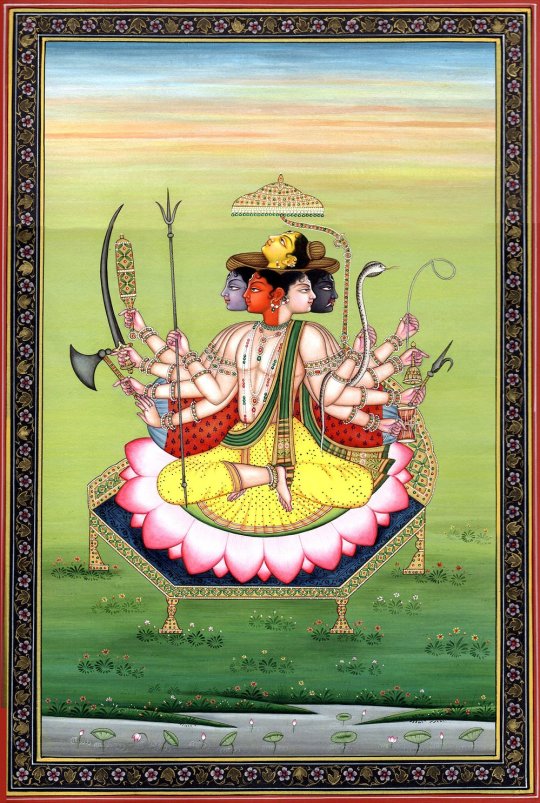
Via Exotic India: Pancha-Mukha Shiva - Water Color Painting on Paper Artist- Kailash Raj
This miniature, a contemporary masterpiece rendered against a turquoise green background in the late 18th century Kangra art style, represents five-faced form of Lord Shiva usually known in the Shaivite tradition as Sadashiva.
This representation almost exactly pursues the iconographic convention of Shiva’s Pancha-mukha form as it initially evolved in early sculptures which have four of his faces carved on all four sides believed to guard all four directions, and the fifth, above the other four skywards-facing. The representation is simply exotic for in miniature paintings the canvas does not have the stone's multi-dimensionality to portray four directions and to plant a fifth, above them. However, this miniature, reproducing a great masterpiece from Kangra in hill region of late eighteenth century, so manipulates the canvas that it imparts a strong sense of multi-dimensionality.
Corresponding to his five faces Shiva’s anatomy has been conceived with ten arms, all carrying his one attribute or other : the right side hands carrying four – trident, thunderbolt ‘mustaka’ or heavy-blow-beat rod, sword and axe, the fifth being held in protective posture – ‘abhaya’, and the left, snake, noose, bell, goad and ‘damaru’, the double-drum. All five heads have their independent hair but in addition also a large basket-type massive ‘jata-juta’ – matted coiffure, cradling on it the fifth head. Except a snake carried in one of his hands merely as an attribute he has neither his usual elephant hide, tiger skin, serpents crawling on his body, skull-garland or anything revealing his ferocious form. On the contrary, in everything : from the iconography of his form – his large fluid eyes, sharp features, hair-style and the style o ear-ornaments, to his modeling and moonlike translucent body-colour, he reveals a strange feminine look.
Instead of seated on his usual tiger-skin this sublime form of the Great Lord has been conceived as seated on a large double lotus installed on a beautifully inlaid hexagonal chowki in cross-legged posture wearing a delicately printed ‘antariya’ – lower wear, reflecting a sari’s look. The figure reveals great benignity and rare divinity. The chowki, enshrining his figure, besides embedded with precious stones, has a high back and an umbrella canopying over Lord Shiva’s form, though like the entire Creation it also falls short of his expanse. A large bolster in maroon-red affording pleasant contrast to his figure’s pearls-like translucent white and his yellow ‘antariya’ is, like the lotus-seat, an element not usually represented in Shaivite iconography. In exact miniature tradition all five faces are in profile. The absence of his mount bull is noticeable. The form of his third eye has been conceived like an ornamental mark on the forehead, not like a feature that awed by its strange grotesqueness.
In Shaivite thought, Shiva is one of the Gods-Trio but also the ever present Sadashiva. The Pancha-mukha cult has broadly two lines, though both accept that it is the manifest form of Sadashiva – the ever present Shiva. Under one tradition, it is in his ‘ling’ form that Shiva has his five faces and that it is the ‘ling’ which is his ultimate manifestation. The ‘ling’ is the ‘jyoti’ – the potential flame, which represents ‘pancha-bhutas’ – the five cosmic elements or constituents of the cosmos. Thus, it is out of him that the cosmos is born. The other tradition is not much different. It conceives Shiva as Ishan, or as ‘Panchavaktramatrinetram’, that is, Shiva combines in him Tatpurusha, Vamadeva, Aghora, Sadyojata and Ishan, representing respectively the wind, the water, the fire, creative function, and the space. Thus again Shiva's five heads manifest the five cosmic elements and functions.
This description by Prof. P.C. Jain and Dr. Daljeet. Prof. Jain specializes on the aesthetics of literature and is the author of numerous books on Indian art and culture. Dr. Daljeet is the curator of the Miniature Painting Gallery, National Museum, New Delhi. They have both collaborated together on a number of books.
Exotic India: Pancha-Mukha Shiva - Water Color Painting on Paper Artist- Kailash Raj
13 notes
·
View notes
Photo
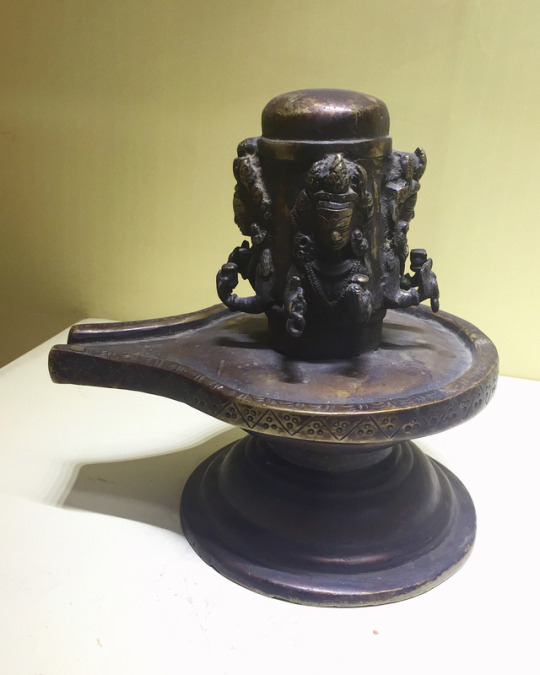
Chaturmukha Linga 18th Century AD Shiva Linga with four faces facing four directions. The faces represented on the Linga are Vamadeva, Tatpurusha, Aghora and Sadyojata. They are holding kundika and pasa in their hands. The pedestal is shaped like an inverted cup. The exterior face of the Panavata is decorated with geometric design. #Contemporary #SivaLinga #Phallus #Gods #GodsOfIndia #Hindu #Hinduism #HinduMythology #ChaturmukhaLinga #ShivaTheDestroyer #Lingam #Bronze #BronzeCasting #StateArchaeologicalMuseum #MuseumsOfIndia #Hyderabad #HyderabadDiaries #HyderabadJournal #Telangana #India #Wanderer #Wanderlust #Travel #Travelogue #TravelDiaries (at State Archaeological Museum, Hyderabad)
#godsofindia#hyderabadjournal#hindu#statearchaeologicalmuseum#lingam#travelogue#chaturmukhalinga#india#contemporary#hyderabad#wanderer#bronze#telangana#gods#wanderlust#museumsofindia#sivalinga#hyderabaddiaries#shivathedestroyer#bronzecasting#travel#hindumythology#traveldiaries#hinduism#phallus
40 notes
·
View notes
